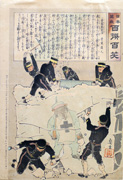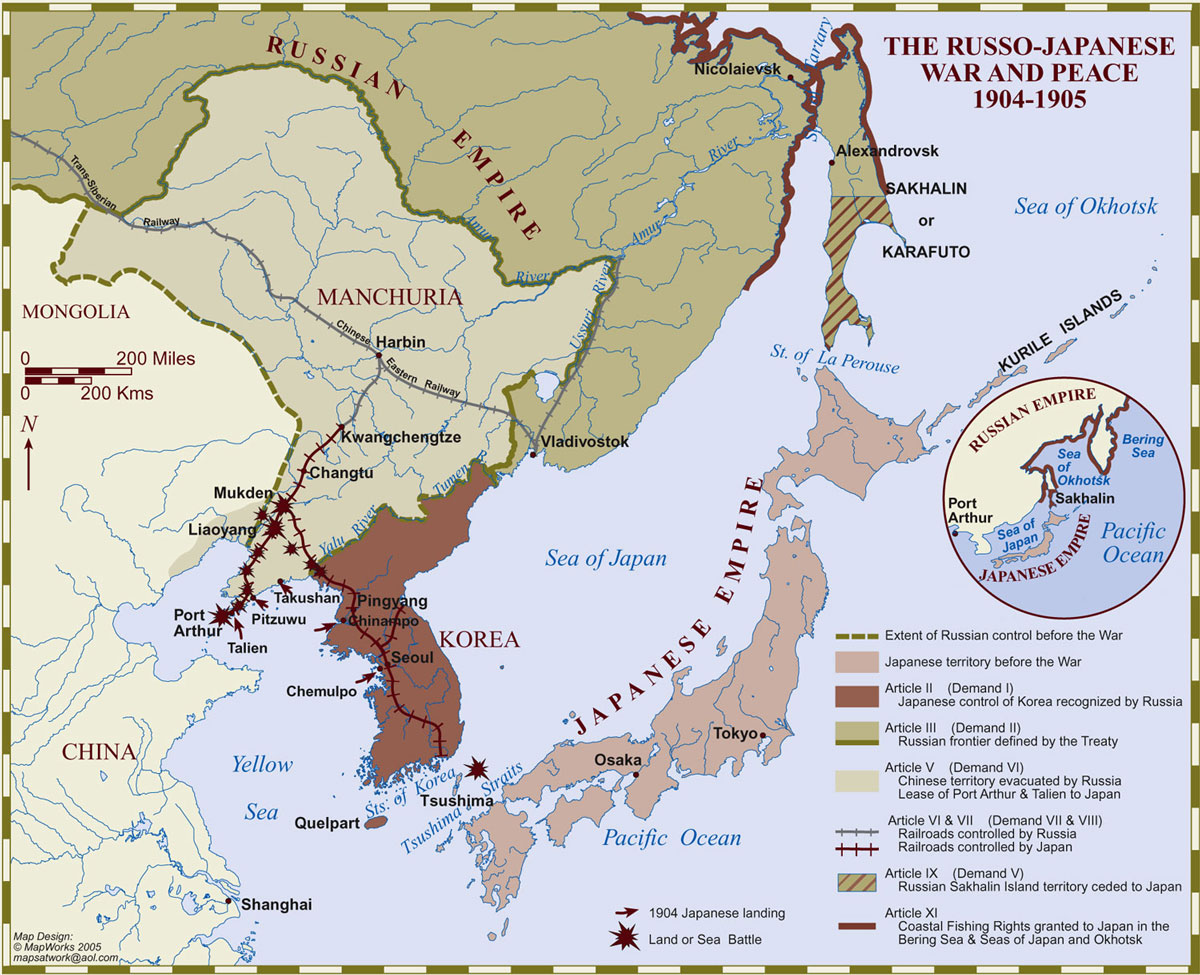Russo-Japanese War Prints in Collection
 Japanese Forces Occupying Yizhou. Russian Soldiers Fleeing to the North Bank of the Yalu, April 1904 Yonehide (active 1904) IHL Cat. #101 | |
Woodblock Prints and the Russo-Japanese War
Although as many as 3,000 triptych designs are estimated to have publicized the victorious battles and heroic deeds of the Sino-Japanese War (1894-1895), reliance on the woodblock medium had diminished considerably ten years later by the start of the Russo-Japanese War (1904-1905). The war with Russia, Japan’s first major conflict with a Western power, was extensively documented in hundreds of Japanese and international newspapers and magazine articles, but relatively few woodblock-printed illustrations were published. The traditional medium was gradually supplanted by the use of novel, less expensive lithography, photography, and mass-produced photoengraving. Furthermore, while most Sino-Japanese War print artists were widely known because they also designed prints with other subject matter (such as cartoons, landscapes, actors, and beautiful women) or because they were also painters or newspaper and book illustrators, the identities and careers of most Russo-Japanese War prints artists are unknown.Artist names such as Banri, Gakyôjin, Getsuzô, Jikkyô, Kakô, Kyôkatsu, Kyôko, Nitei, Rosetsu, Itô Seisai, Shinohara Kiyooki, Hirose Yoshikuni, Yonehide seem to have appeared out of nowhere to create battle prints. Little, if any, biographical information is available on these artists.
Compared with prints of the war with China, the majority of Russo-Japanese War prints are more matter-of-fact and descriptive in their renderings of battle scenes.
However, according to the following first-hand account by the Frenchman Paul-Louis Couchoud1, the prints still made an impressive display:
27th February (1904). The prints of war subjects are making the shopwindows brilliant. About a hundred have already been published. On thetossed violet of waves a burning ship smolders, and in the long rosestreak of its reflection a black torpedo boat slinks away. Anothershows a blinding snow, composed of particles of shattered plaster, anda group of blue blouses crowding about a cannon; the faces grimace intheir excitement and in the background, in a pale vermilion light, aboat is on fire. The theme of the imaginative treatment of a navalcombat is varied in countless ways. The crowds gather beforethese prints and examine them in a silence of concentration. Theartists fulfill the part of educators. One of the newspapers hascomplained that the depiction is too flattering to the Japanese, anddemands a more realistic respect of truth. |
The print were also less racist, although still mocking, in their depiction of the enemy. This can be attributed to Japan's continuing infatuation with and respect for Western nations, even enemy nations.
Russo-Japanese War, 1904-1905
The Russo-Japanese War of1904-1905 marked the first major defeat of a European power by an Asiancountry in the modern era. Tsarism's humiliation in the Pacific was the firstin a series of convulsions that would ultimately topple the Romanovdynasty. The confrontation in Manchuria, with its enormous landbattles involving the use of trenches, artillery barrages, and machinegun fire, heralded many of the murderous innovations of World WarI. For these reasons, the conflict that pitted Eurasia's largest landempire against the rising East Asian power is one of the pivotal eventsof the twentieth century.click on map to enlarge
Map of Conflict
Source: http://www.portsmouthpeacetreaty.com/process/peace/images/F-Article-DemandsLg.jpg
Source: http://www.portsmouthpeacetreaty.com/process/peace/images/F-Article-DemandsLg.jpg
Literature
A Much Recorded War: The Russo-Japanese War inHistory and Imagery, Fredrick A. Sharf, Anne NishimuraMorse, Sebastian Dobson, MFA Publications, 2005.In Battle's Light: Woodblock Prints of Japan's Early Modern Wars, Elizabeth de Sabato Swinton, Worcester Art Museum, 1991.
New Wine in Old Casks: Sino-Japanese andRusso-Japanese War Prints, Elizabeth de Sabato Swinton, article in "Asian Art" Volume VI, Number 1, Winter1993, Oxford University Press.
1 Japanese Impressions, Paul-Louis Couchoud, translated from the French by Frances Rumsey, John Lane Company, 1921 http://www.archive.org/stream/japaneseimpressi00couciala/japaneseimpressi00couciala_djvu.txt











